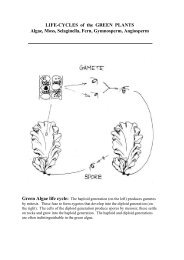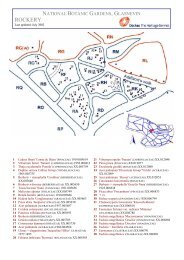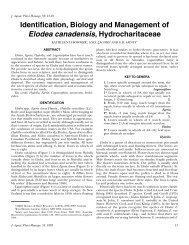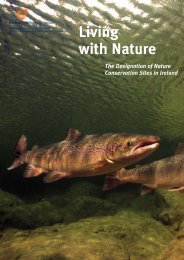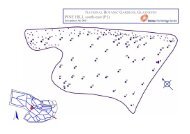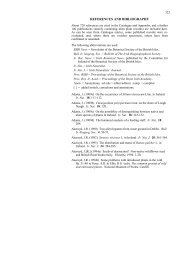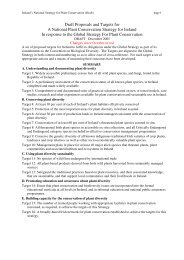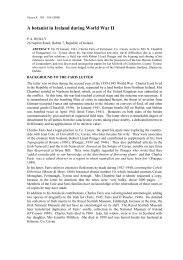From Swanley to Glasnevin - National Botanic Gardens
From Swanley to Glasnevin - National Botanic Gardens
From Swanley to Glasnevin - National Botanic Gardens
You also want an ePaper? Increase the reach of your titles
YUMPU automatically turns print PDFs into web optimized ePapers that Google loves.
Glasra 4: 59–61 (2000)<strong>From</strong> <strong>Swanley</strong> <strong>to</strong> <strong>Glasnevin</strong>MARY FORRESTDepartment of Crop Science, Horticulture and Forestry, University College Dublin, Belfield,Dublin 4.VALERIE M. INGRAMThe Library, The Office of Public Works, 51 St Stephen’s Green, Dublin 2.ABSTRACT: The his<strong>to</strong>ry of female students who attended the <strong>National</strong> <strong>Botanic</strong> <strong>Gardens</strong> (Ingramand Forrest, 1997) is continued following an examination of <strong>Swanley</strong> archives. Brief biographicalnotes are given on four students from the Horticultural College at <strong>Swanley</strong>, who attended <strong>Glasnevin</strong>,namely: Rose Bar<strong>to</strong>n (1906), Mary Helen Graves (1898), A. Margaret MacIntyre (1906), andGertrude Webb (1898). Biographical details of Mary Helen Graves shed light on her decision <strong>to</strong>come <strong>to</strong> study in <strong>Glasnevin</strong>.INTRODUCTIONA previous paper, '<strong>From</strong> Lady Pupil <strong>to</strong> Lady Gardener' (Ingram and Forrest, 1997) outlinedthe his<strong>to</strong>ry of twenty female students who attended the <strong>National</strong> <strong>Botanic</strong> <strong>Gardens</strong>,<strong>Glasnevin</strong> in the period 1898 <strong>to</strong> 1942 and provided information on their subsequentemployment. In a letter <strong>to</strong> the Science and Art Museum in 1898, Frederick Moore, theKeeper of the <strong>Gardens</strong>, named Gertrude Webb and Mary Graves ‘who had passed a coupleof years at <strong>Swanley</strong> College’ as the first ‘lady gardeners’ (1). Records of subsequent,though not all, lady gardeners appear in manuscript registers entitled ‘Came’, ‘Left’ and‘Lady pupils’ at <strong>Glasnevin</strong> (2,3,4).<strong>Swanley</strong> Horticultural College commenced in 1889, providing education for male and femalestudents. In 1891 it became a college for female students only. Courses of two or threeyears duration were provided and students were awarded certificates and diplomas (Janes,1907). It continued at <strong>Swanley</strong> until 1945 when the property was bombed and the Collegebecame part of Wye College, Ashford, Kent.Some information located in 1999 in the archives of Wye College, and the Royal <strong>Botanic</strong><strong>Gardens</strong> (R.B.G.), Kew, highlights connections between the Horticultural College, <strong>Swanley</strong>,Kent and the Royal (now <strong>National</strong>) <strong>Botanic</strong> <strong>Gardens</strong>, <strong>Glasnevin</strong> in the years 1898 <strong>to</strong> 1916.Biographical details of Mary Helen Graves shed light on her decision <strong>to</strong> come <strong>to</strong> study in<strong>Glasnevin</strong>.The names of Gertrude Webb, Mary Helen Graves, Rose Bar<strong>to</strong>n and A. Margaret Mac Intyreappear in <strong>Glasnevin</strong> manuscript sources and in the Dept of Science and Art of theCommittee of Council on Education, General Register of the Horticultural College <strong>Swanley</strong>Kent (5). The Register records name, address, date of commencement and completion ofcourse, and father’s occupation for each student. The register ‘Lady Pupils’ (4) notes thenames of four other <strong>Swanley</strong> students who applied <strong>to</strong> study at <strong>Glasnevin</strong>.THE SWANLEY STUDENTSGertrude Webb was aged 27 when she entered <strong>Swanley</strong> on 4 May 1896. She left in April1898. Her address was given as the Horticultural College and her father's occupation waslisted as gentleman. She commenced her studies in <strong>Glasnevin</strong> on 20 June 1898.Mary Helen Graves’s address was Red Branch House, Wimbledon, London and herFather’s occupation was given as H.M. Inspec<strong>to</strong>r of Schools. She began her studies at
60 M. Forrest & V. M. Ingram<strong>Swanley</strong> aged 19 on 25 January 1897 and left on 3 August 1900. A later record states thatshe started in the college on 11 September 1899 and left on 3 August 1900. She must havespent a year in <strong>Swanley</strong>, followed by a year in <strong>Glasnevin</strong>, before returning again <strong>to</strong> <strong>Swanley</strong>.Further details about Mary Graves were located in Robert Graves the assault heroic(Graves, 1986) and Robert Graves his life and work (Seymour-Smith,1995). Mary Graves(1877 – 1949?) was a half sister of the poet Robert Graves. Her father, Alfred PercevalGraves, was born in Dublin and was also a poet and writer of ballads, the most well knownbeing ‘Father O’Flynn’. Her grandfather Charles Graves was Bishop of Limerick. She isdescribed by Graves (1986) as the first woman <strong>to</strong> pass the Royal Horticultural Society’sexamination in horticulture. This is not the case; 23 women were successful in thatexamination in 1898. Mary Graves achieved a first class result with 270 marks gained(Anonymous, 1898-1899). She was later described as working as a gardener at the <strong>Botanic</strong><strong>Gardens</strong> <strong>Glasnevin</strong>, where she was in charge of the orchid collection (Graves, 1986).However she is not included on staff lists of the period. During the year 1898 – 1899 whenshe was a ‘lady pupil’ she may have worked in the orchid house. Perhaps she was attracted<strong>to</strong> spend the year studying in Dublin because her aunt, Lady Grace Pontifex, lived there andshe also had a granduncle, Robert Graves, who was subdean of the Chapel Royal in DublinCastle and vice warden of Alexandra College Dublin. In 1902 she went <strong>to</strong> Egypt where shemet and married Arthur Pres<strong>to</strong>n, a solici<strong>to</strong>r who later became a judge. They had threechildren, Janie, Roseen and Martin. Mary went <strong>to</strong> France <strong>to</strong> work as a nurse in World War I.She was also a water diviner.The references in F. W. Moore's letter and the Register were the only ones relating <strong>to</strong>Gertrude Webb and Mary Helen Graves <strong>to</strong> be located in <strong>Glasnevin</strong> or <strong>Swanley</strong> archives.Rose Bar<strong>to</strong>n was 30 years old when she began <strong>to</strong> attend <strong>Swanley</strong> on 14 September 1904.She left the College on 11 April 1906. Her address was 15 Landsdown Place, Cheltenham andher father's occupation was landlord. In 1905 she applied <strong>to</strong> <strong>Glasnevin</strong>, with arecommendation from William Edward Gumble<strong>to</strong>n of Belgrove, Co. Cork and was acceptedfor July 1905 but deferred taking a place until a year later (Lady pupils (4)). TheHorticultural College Magazine, a <strong>Swanley</strong> publication, notes that Miss Bar<strong>to</strong>n and MissMac Intyre were at <strong>Glasnevin</strong> (Anonymous, 1907). In 1911 Rose Bar<strong>to</strong>n wrote an article forthe Horticultural College Magazine, describing her time in <strong>Glasnevin</strong> working in the Pitsand in the Locked Garden, perhaps what is now called the Enclosed Garden. She alsodescribed evening lectures and 'strolling lectures' given by the Keeper. It is unclear whethershe later worked as a gardener. In a 1915 issue of the Horticultural College Magazine,Miss Bar<strong>to</strong>n is described as an assistant cook in one of the Red Cross hospitals inCheltenham (Anonymous, 1915a). A register of Guild members given in the HorticulturalCollege Magazine in 1924 gives her occupation as housekeeping for an invalid mother.A. Margaret Mac Intyre attended <strong>Swanley</strong> from 14 September 1904. She was fromMackenzie Lodge, Fortrose, Scotland and her father was a soldier. She remained in <strong>Swanley</strong>for two years, then went <strong>to</strong> <strong>Glasnevin</strong> in August 1906. The 1907 edition of the HorticulturalCollege Magazine refers <strong>to</strong> her being a student in the R.B.G. <strong>Glasnevin</strong> (Anonymous, 1907).There is no record of her actual application <strong>to</strong> the <strong>Gardens</strong>. In 1915 she was appointed as agardener at R.B.G. Kew and she was later described as working in the Rock Garden(Anonymous, 1915 b). In 1916 she became sub-foreman in the Herbaceous Department andwas in charge of the frames and pit for Alpines (Anonymous, 1916). Records at Kew statethat she worked there from 8 June 1915 <strong>to</strong> 15 July 1916. The printed staff list for the periodsays that J. Divers, sub-foreman of the Herbaceous Dept was 'absent on Military duty’.There were 22 female gardeners in Kew in 1916 (Kate Manners, pers. comm. 1999).
FROM SWANLEY TO GLASNEVIN 61The Lady pupils notebook (4) records the names of the following <strong>Swanley</strong> students whoapplied <strong>to</strong> <strong>Glasnevin</strong> but did not accept a place. Miss J. Barlow of South Bank, <strong>Swanley</strong>,Kent, applied <strong>to</strong> <strong>Glasnevin</strong> in Oc<strong>to</strong>ber 1906 but was not offered a place until 1908 when sherefused it. Miss M. Legg of South Bank, <strong>Swanley</strong>, Kent also applied in 1906 and wasoffered a place in 1908. Miss E. R. Thorn<strong>to</strong>n of South Bank, Hextable, Kent applied on 15July 1910 for any vacancy occurring before 1914. She was offered a place in 1915. TheHorticultural Magazine records her address as Lissory, Portadown, Co. Armagh. Miss S.Dill, with an address of the Horticultural College, <strong>Swanley</strong>, applied <strong>to</strong> <strong>Glasnevin</strong> in July 1913and was offered a place on 5 November 1915. In the Horticultural Magazine her address isgiven as Montpelier, Malone Road, Belfast. In view of the time lapse between applicationand the offer of places it is not surprising that these women were no longer available <strong>to</strong> fillthem.REFERENCESAnonymous. 1898-1899. Examination in Horticulture. Journal of the Royal HorticulturalSociety 22 : 94 – 102.Anonymous. 1907. The Horticultural College Magazine 7 (1) 19: 21 – 22.Anonymous. 1915a. Jottings. The Horticultural College Magazine 13 (11) 36: 15.Anonymous. 1915b. Jottings. The Horticultural College Magazine 13 (11) 36: 21, 23.Anonymous. 1916. Jottings. The Horticultural College Magazine 14 (11) 37: 16.Graves, R. P. 1986. Robert Graves the assault heroic 1895 – 1926. London: Weidenfeldand Nicholson.Ingram, V.M. & Forrest, M. 1997. <strong>From</strong> lady pupil <strong>to</strong> lady gardener. Glasra 3 (1): 55 – 62.Janes, E. (edi<strong>to</strong>r). 1907. The Englishwomens Yearbook and Direc<strong>to</strong>ry. London: Adam andBlack : 52.Seymour-Smith, M. 1995. Robert Graves his life and work. London : Bloomsbury.MANUSCRIPT SOURCES<strong>National</strong> <strong>Botanic</strong> <strong>Gardens</strong>, <strong>Glasnevin</strong>, Dublin(1) Letters book 1898: F.W. Moore <strong>to</strong> G.E. Plunkett, Direc<strong>to</strong>r, Science and Art Museum,Dublin, 20 November 1898.(2) Came: ms notebook, c.1894-1944 (alphabetical/chronological listing of staff andapprentices, with date of birth and date of commencement).(3) Left: ms notebook, c. 1894-1943, (alphabetical/chronological listing of staff andapprentices, giving dates and reasons for departure).(4) Lady pupils: ms notebook, 1903-1929 (119 numbered entries) (on back cover isinscription ‘Lady Gardeners wanted’). Wye College, Ashford, Kent.(5) General Register of the Horticultural College <strong>Swanley</strong> Kent, Dept of Science and Art ofthe Committee of Council on Education. 1891 - 1912.ACKNOWLEDGEMENTSMs Hilary McEwan, Archivist, and Ms Mary Lucas, Librarian, Wye College, Ashford, Kent.Ms Kate Manners, Archivist, Royal <strong>Botanic</strong> <strong>Gardens</strong>, Kew. Ms Sarah Ball, Librarian,<strong>National</strong> <strong>Botanic</strong> <strong>Gardens</strong>, <strong>Glasnevin</strong>. Ms Anne Meredith who drew our attention <strong>to</strong> thekinship of Mary Graves and Robert Graves.



